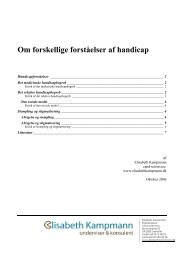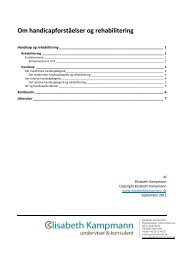Handicappet uden diagnose - Elisabeth Kampmann
Handicappet uden diagnose - Elisabeth Kampmann
Handicappet uden diagnose - Elisabeth Kampmann
Create successful ePaper yourself
Turn your PDF publications into a flip-book with our unique Google optimized e-Paper software.
English Summary<br />
The purpose of this paper is to examine the relations between medical diagnosis and the<br />
construction of the category disability and to look closely into the role that medical diagnosis<br />
plays for the understanding of deviance. I am looking at the subject in relation to children<br />
with disabilities. I look after the role of diagnosis in the construction of disability in relation<br />
to identity of the child and relations to family and friends in the lifeworld. I also look at the<br />
importance of the medical diagnosis in relation to social assistance and grants.<br />
My theoretical starting point is an understanding of disability as a social construction. I<br />
supplement this understanding with a relational understanding influenced by theories of<br />
symbolic interactionism.<br />
The material on which my investigation is built is qualitative interviews – two interviews with<br />
skilled social workers working with disabled children in local authorities and four interviews<br />
with parents to disabled children. Two of the children has got a diagnosis (the same) and the<br />
other two has not got any in spite of the fact that the hospital system has done huge efforts to<br />
find one. All of the four children are classified as delayed regarding psychomotoric<br />
development. Furthermore my material consists of texts: the legislation of social assistance<br />
and other substantial texts both governmental and from user organisations of disabled people.<br />
Using critical discourse analysis as a method for my investigation I analyse the texts<br />
mentioned above and thereby determine the order of discourse in the disability area in<br />
Denmark.<br />
I find that the primary discourse in the order of discourse is the equality/inequality discourse,<br />
but I also find elements of a normality/deviance discourse. The equality/inequality discourse<br />
emphasises the material aspects. The welfare state is expected to compensate for the problems<br />
in different areas of life where disability causes problems. It also emphasises equality in<br />
citizen-ship and participation in democratic life for the disabled. The legislation dissociates<br />
from the individualistic and diagnostic view of disability and emphasises the relation between<br />
the subject and his surroundings as the ground for social assistance.<br />
Through the analysis of the interviews I find that a medical diagnosis is important for the<br />
construction of the category of disability and thereby for understanding of the child. I also<br />
find that it is much easier in the lifeworld to understand and explain to others the deviance of<br />
the child – when there is a diagnosis. The insecurity in interaction with disability can be<br />
reduced by the medical explanations that the diagnosis offers.<br />
1






